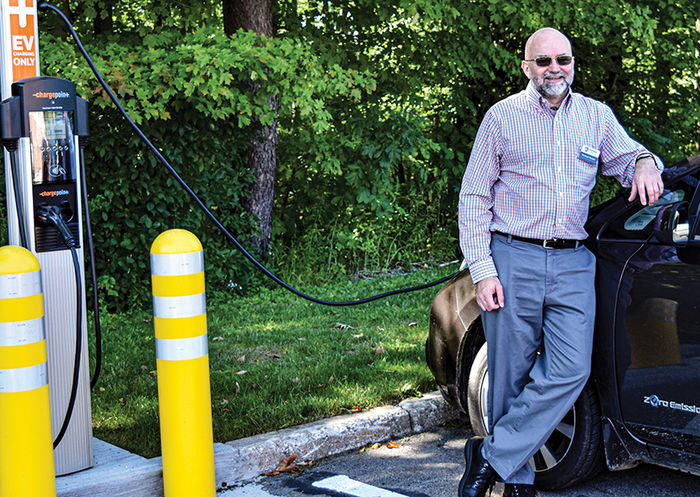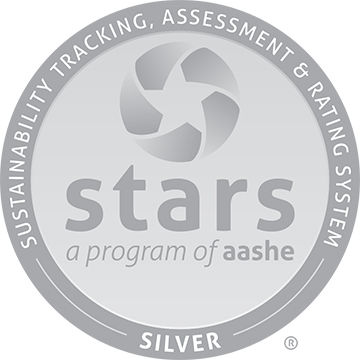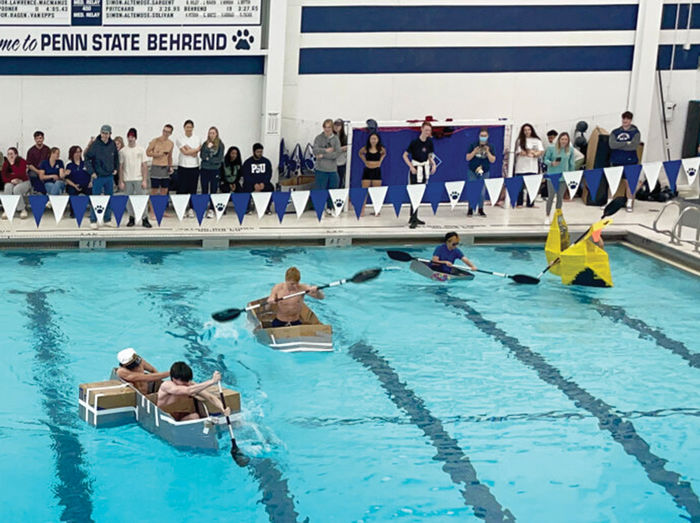New EV Charging Stations Installed
The first time Dr. Michael Rutter, associate director of the School of Science and associate professor of statistics at Penn State Behrend, charged his Nissan Leaf on campus, a man walking nearby stopped to watch. A plugged-in car is still an unusual sight at Behrend, and Rutter was the first person to use one of the college’s new electric vehicle (EV) charging stations, which came online this past fall.
Behrend is the first higher education institution in the region to provide EV chargers on campus. They are available to all members of the Behrend community and to the public.
“That makes me proud,” said Dr. Sherri “Sam” Mason, director of sustainability at Behrend. “This really encapsulates the role that higher education should play in providing a vision for the future and demonstrating how to embody it.”
The college has installed three charging stations: two in the Prischak parking lot, near the School of Science, and another in the Burke Center parking deck. Each station has two ports and is geolocated on the ChargePoint app.
“We’re part of this network,” Mason said. “People can charge their cars while they walk in Wintergreen Gorge or on campus.”
Nature of Behrend
Behrend is known for its beautiful campus and variety of habitats—wetlands, woods, grasslands, marshes, Wintergreen Gorge, and much more. The Office of Strategic Communications has launched a series, Nature of Behrend, to highlight some of the remarkable natural features of campus. Check it out every Monday at facebook.com/pennstatebehrend and Instagram.com/psbehrend.
Behrend Shines Bright
College earns silver STARS rating for sustainability achievements Penn State Behrend recently earned a silver rating from STARS, the Sustainability Tracking, Assessment and Rating System. The designation, which is valid for three years, is a measure of the college’s work toward environmental, social, and economic sustainability.
Behrend previously held a bronze rating from STARS, which is a program of the Association for the Advancement of Sustainability in Higher Education. No other college in northwestern Pennsylvania holds a STARS rating.
The college’s initial rating, in 2020, provided a baseline assessment of Behrend’s sustainability work, which is viewed through five primary categories: academics, engagement, operations, planning and administration, and innovation and leadership.
“STARS provided a way to get people across campus involved,” said Dr. Sherri “Sam” Mason, director of sustainability at Behrend. “It also highlighted that sustainability is about everything: how much water we use; the food that we serve; our diversity, equity and inclusion priorities; what’s happening in our classrooms; and how we landscape.”
The report also identified areas for improvement. Mason works with faculty members across the college to incorporate elements of sustainability in the learning outcomes of their courses. She has also expanded the college’s sustainability- based engagement, using peer-topeer learning and outreach through the Sustainable Food Systems program, and she has begun a Sustainability Ambassadors program. Students in her inaugural class were actively involved in reporting STARS data.
“What I really want people to know is that we all have a role in sustainability,” Mason said. “It’s not the domain of the scientists or the engineers. It’s not the domain of faculty only. It’s the domain of every school of our college, and every person who works and learns here.
Students Can Spend Summer in the Vineyards
Students interested in viticulture or food science, have the opportunity to apply for a nine-week summer internship opportunity at Penn State’s Lake Erie Regional Grape Research and Extension Center (LERGREC) in North East, about 12 miles from the Behrend campus. LERGREC serves the Lake Erie Grape Belt—the largest viticultural area in North America outside of California. Interns receive a stipend and housing, while training in viticulture, vineyard management, and enology and working with commercial partners in the wine and juice industry. Learn more at behrend.psu.edu/grapesummer.
Faculty News
New Faculty
The School of Science welcomed three new faculty members: Dr. David Bialas, assistant professor of chemistry; Natalie DeVos, lecturer in mathematics; and Benjamin Gerstner, visiting assistant teaching professor of biology.
Promotions
Dr. Adam Simpson was promoted to associate teaching professor of biology, and Gabe Kramer was promoted to assistant teaching professor of mathematics.
Awards
School of Science faculty members were recognized with these awards: Dr. Lynne Beaty, assistant professor of biology, School of Science Award for Outstanding Mentoring; Dr. Dustin Hemphill, assistant teaching professor of physics, School of Science Award for Outstanding Accomplishments in Research and Scholarly Activity; Dr. Samuel Nutile, assistant professor of biology, Dave Falvo Award for Excellence in Teaching; Dr. Beth Potter, associate professor of biology, Penn State Behrend Council of Fellows Faculty Excellence in Outreach Award; Jodie Styers, associate teaching professor of math education, School of Science Award for Outstanding Accomplishments in Service and Outreach; and Dr. Blair Tuttle, professor of physics, Penn State Behrend Council of Fellows Faculty Research Award.
Bungee-Jumping Barbies Show Math in Action
It was a bad day to be a Barbie.
In a classroom at Penn State Behrend’s Burke Center, a group of middle-schoolers tied the feet of several Barbie dolls to long, stretchy chains of looped rubber bands. Then they dropped the dolls, head-first, toward the floor.
Some of the Barbies dipped close to but didn’t hit the carpet. That was the goal of the workshop—to demonstrate Hooke’s Law, which explains elasticity: A material’s ability to return to a normal shape after distortion. Other Barbies—and, for equity, a few Kens—thwacked against the floor.
The session was part of Behrend’s annual Math Options Career Day, which brought nearly 250 seventh-and-eighth-graders to the college for hands-on learning activities designed to generate interest in science, technology, engineering, and mathematics. This was the twenty-eighth year for the program, which is designed to encourage middle-school students to pursue advanced math studies.
“Advanced math is going to give students more options down the road,” said Melanie Ford, director of Youth Education Outreach and the Engineering K-12 Outreach Center at Behrend. “In seventh grade, you don’t always know what those options are. Programs like this allow teachers to add the ‘why’ to what they are teaching in the classroom.”
Fun With Physics (and Duct Tape and Cardboard)
People say duct tape can fix anything. Maarten Van Hees, lecturer in physics, challenged would-be sailors to prove it at the second annual Cardboard Boat Race, held on campus this past fall. The task: build a floating vessel out of nothing but cardboard and duct tape and paddle it 25 yards across the pool in Behrend’s Junker Center.
“The event is meant to show the fun side of physics,” Van Hees said. “We are experimenting with buoyancy.”
While cardboard floats, it, of course, falls apart when it gets wet, so the duct tape is used to make it sturdy and reliable enough to survive a race across the pool. In constructing their boats, teams must account for the added mass of people in the boat.
“They have to figure out how high to make the walls and how big to make the base,” Van Hees said. “Do you build a really big boat and sacrifice speed, or do you build a smaller, shallower boat that can move faster, but is more likely to get wet and sink?”
That’s where the fun begins. “All the teams prioritize different things,” Van Hees said, “and then when the races start, everyone has a blast seeing how each team designed its boat, and what worked well and what did not.”
The event involved teams from Behrend and Erie-area middle and high schools. The event included a design competition, a middle/high school division, and a float competition trophy awarded to the team with the boat that floated the longest without taking on water.
Whether teams sank, finished, or floated somewhere in between, Van Hees said they all left with a sense of accomplishment and joy, which is the whole point.
“That is truly my goal: to inspire students to find the joy in places they normally wouldn’t think to look for it, like physics,” he said.
Gorge Trail Improvements Continue
Phase Two of trail improvements in Wintergreen Gorge was recently completed, extending the aggregate-topped path to Trout Run. The compacted aggregate surface is porous, allowing rain to penetrate it, but solid enough to make the trail more accessible to visitors in wheelchairs and those pushing strollers. A new boardwalk protects a marshy area near Fourmile Creek, and wattle fencing discourages users from creating additional footpaths that can damage vegetation and trees and cause erosion along the creek bank.
Phase Three of the improvement plan will entail removal of a culvert and creation of a bridge across Trout Run. That phase will begin once funding is secured, possibly in the fall of 2024.


